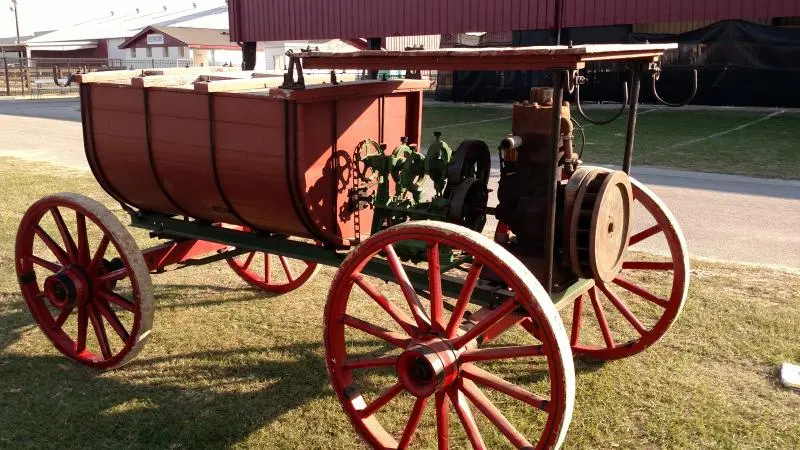
What a beautiful machine and so well taken care of.
I know them well. The pump is a John Bean model "giant triplex". The engine is a Novo that was built under license by John Bean. The tank looks like a 200 gal, all I have seen from Bean of that time were made of clear, vertical grain redwood. They were a work of art, would just about last forever if halfway maintained. I never saw one on wooden wheels; they were on steel-spoke wagon wheels with about a 5" wide steel tire.
Novo was a poor choice of engine, thus the nickname "Nogo." At the time Hardie was selling a similar rig with a Cushman engine built by Cushman. They always started, thus cost Bean a LOT of sales.
The valves on that pump are a caged ball system. The cage held the seat tight in the base of the pump, and had to seal on a flat gasket on the top flange of the cage. Therefore, all holes had to be machined exactly the proper depth from top gasket surface to bottom inside gasket surface, and the cage, two gaskets and seat had to exactly match that depth. They were looking for trouble and found it.
However, a lot of these were sold and used with success. They were seldom used at pressures over 200 psi because of the gasket problem. They were succeeded by the "Super" series which was stronger built, but still plagued with the valve problems. "Super" was succeeded by the horizontal "Royal" series which has never been matched by anyone for service and longevity because of the enclosed, oil-filled crankcase, all roller bearing lower end, and taper-seated valve seats. After the Royal pumps hit the scene, no one wanted much to do with the giants and supers and they mostly went to scrap after the war.
You have happened onto a beautiful example of a long-gone type of sprayers from the early development stage. It seems to be in very good shape for a sprayer (very corrosive chemicals) that must be around 90 years old, maybe more. Please handle with care!
Jack
I did a little remembering on the last Giant I junked out over 60 years ago. The pump discharged into a regulator which was hung on the RH side of the pump, looking at it from the rear. It was a two-valve regulator with a diaphram pressure control. One valve was the pressure regulator valve, the other was a check valve which would hold pressure on the hoses when the regulator unloaded the pump at max set pressure. They used an air chamber to maintain pressure when unloaded and to absorb the pulsing from the pump. The one I junked was a Giant Duplex--two cylinder. It was plumbed with 3/4" pipe, except the suction side which was 1" or maybe 1-1/4". The regulator had three pipes connected: discharge from the pump, pressure to hoses and air chamber, and an overflow back to the tank. There also was a manual pressure relief from the hose/air chamber line that had a valve by which you could let off all pressure while idling, mixing spray, starting the engine, etc.
The duplex I junked had two hose bibs for two guns, one on each side of the back end. Your triplex would be expected to have three or four valves, normally. The Bean high-pres hose bib was a complex thing with a stainless steel ball attached into a brass stem and seated in a brass seat. There was a packing around the stem which leaked, and they wouldn't shut off completely after a short time. They were replaced asap and very few survive. I may have one or two in the junk piles, but they are strictly for looks.
The air chamber they used at the time was a round sphere of cast iron. It wasn't really big enough and a lot of them got replaced. As to the exact routing of the pipes, I do not know. Most of the old rigs were changed around to suit individual farmer's ideas and methods.
The engine was already gone to salvage when the Duplex arrived to me. I never got to tinker with that one. Most of the old sprayers ran until the engine gave out, and then got repowered with a Star car engine or some such. In this area Star was the favorite. They were small and light weight and very dependable. And, they had an electric starter!
I hope this helps.
Jack
Thanks for the information Jack! Just your ID of the pump and engine lead me to a few pics and vintage ads. I think I will be fixing the unit for the guy to show.